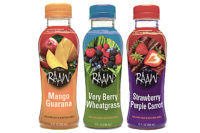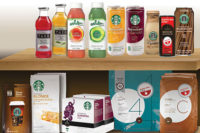![]()
Anytime, Anywhere: Self-heating Containers
In a society where everyone appears to be in a rush, global
packaging company Sonoco, and the California limited liability company OnTech,
have reached an agreement that will provide those on-the-go people with self-heating
containers for hot beverages. For years, creators Dan Gibbs, James Berntsen,
Jim Scudder and their team have been designing this innovative technology. James
Berntsen notes that, “My partners and I noticed that self-heating technology
has been around in Europe and Japan for many years, but the products had several
issues surrounding them. We wanted to develop a container that was safe, reliable,
easy-to-use and that could be manufactured in large quantities, which would
make it affordable to customers. We saw it as a great opportunity to revolutionize
how individuals eat and drink hot food.”
After the product was complete, OnTech partnered with Sonoco
to manufacture the product and Lakeside Foods to do the filling and retorting.
Charles Sullivan Jr., senior vice president at Sonoco notes that, “The partnership
with OnTech is a natural fit for both companies. We believe that with OnTech,
we will be able to bring this technology to market and satisfy the growing demand
for convenient, ready-to-eat foods and beverages.
The self-heating container looks like an ordinary can.
However, inside is ground-breaking technology. The can contains an outside
cylinder that is combined with an inside cone to form a can within a can.
The cone is then filled with crushed limestone. Additionally, a plastic
puck filled with water and a tamper-proof foil is contained inside the
cone. Finally, the can is filled with a beverage and sealed. When those
on-the-go, busy consumers decide that they would like to enjoy their coffee
or soup, they simply remove the foil and push the button down. The pressure
releases the water into the limestone, and the combination of both elements
creates a natural thermal reaction. The can begins to heat up, and after
six minutes, the beverage is ready to be enjoyed. However, the individual
does not have to worry about drinking their coffee right away; the
self-heating container remains hot for at least 30 minutes and warm for an
hour.
Sullivan says, “The
containers will be used for packaging coffee, teas, cocoas, soups, baby
formula, and other foods and beverages for anytime, anywhere
consumption.”
James Berntsen also notes that, “We have been
doing a lot of market research on the product. We have worked with
customers to do tests, such as the national AC Nielsen Bases Test, which
show that there is a huge market for this kind of product.” In fact,
OnTech has worked with food and beverage manufacturers to sell and market
the product to the public. Companies, such as Wolfgang Puck and a large
coffee company, will use the technology with their products. The final
results can be seen on the shelf of grocery stores in the fourth quarter of
this year for approximately $2.
In the future, Berntsen believes the technology will
be used for products such as alcohol beverages, baby formula and even full
meals. With Americans constantly running around and trying to pencil in
eating or drinking into their schedules, it’s a safe bet that OnTech
and Sonoco’s agreement could help alleviate some stresses of busy
lives and hectic schedules
Coca-Cola launches unexpected surprises for summer
Summer is a time of
excitement, possibilities and adventure. With that in mind, Coca-Cola,
Atlanta, Ga., announced the launch of its “unexpected” summer campaign. The campaign features 120 Coke cans
distributed around the United States that will feature a Global Positioning
System and a cell phone. The lucky winners who
find the can will be awarded a Chevy Equinox SUV. However, finding the
winning can is only the first step to this exciting and innovative
campaign. The true adventure begins when the consumer activates the cell
phone. According to Doug Rollins, brand manager, Coca-Cola Trademark,
“We have a dedicated search team of five different teams located all
around the country. When a person activates the cell phone, we will
mobilize the closest search team, so they can find the consumer.”
From that point on, consumers have to keep the winning
can on them at all times, and the search team will use the GPS to locate
the consumer.
According to Rollins, this innovative idea was first
used with Coke cans in Australia. “When we saw how much of a success
the promotion was in Australia, we knew that we could use it in the
States,” he says.
The technology has changed
a bit from the first campaign. In Australia, the cell phone was just
dropped into the cans while in America, the technology was actually
integrated into the cans. Rollins notes that, “The whole theory
behind the promotion is not the prize itself but the way we find the
winners. We enter consumers’ lives and bring them unexpected
excitement and adventure like they may have never had before.”
Besides the technology used in the promotion, the
packaging is also unique. Case carriers feature globe graphic to
communicate the vastness of the promotion, and when stacked together on
display, the cases are designed to create one large globe image. Graphics
on the winning cans themselves also are distinct in that they feature three
icons on the side of the can and a power button to activate the cell phone.
From concept to execution, the innovative campaign
took approximately 10 to 11 months to develop, but the wait was worthwhile.
As Rollins notes, “This is our biggest program of the year. We are on
the forefront of technology, and hence, have very high hopes for business
results.”
With TV, radio and Internet to promote this campaign,
Rollins hopes the promotion shifts how people see Coca-Cola. Available
until July 12th or while supplies last, cans can be found in specially
marked 12-, 18-, 20-, or 24-packs in varieties of Coca-Cola Classic,
Caffeine-Free, Cherry Coke and Vanilla Coke
What’s on the outside does matter
The bottled water industry
is a more than $35 billion global market, and with the increasing sales,
more and more people are trying to find ways to
differentiate their water. MeadWestVaco, Atlanta, Ga., has also gotten in
on the competition. Glynn Grisham of MeadWestVaco believes that,
“packaging really makes or breaks a product,” and MeadWestVaco
has started to use paperboard packaging that allows take-home convenience
and makes it easier for companies to market themselves on the package
itself. Bottlers such as Absopure have worked with MeadWestVaco to create
FridgeMaster packs for water, proving that in the end, what’s on the
outside does after all matter.
Another anniversary
Whether it is a 50-year
wedding anniversary or an anniversary of a first kiss, there’s a
reason to celebrate everything. Bridgeport Brewing and Hillebrand Wines are
commemorating their success with anniversaries this year.
Bridgeport Brewing, Portland, Ore., recently launched
its new campaign to honor its anniversary. In order to do justice to the
tradition and history of the brewing company, a 20th anniversary beer,
Ropewalk Amber Ale., was designed, along with packaging that features a
stage highlighted by red curtains, spotlights and a tightrope. The rope
symbolizes the Bridgeport building’s roots as a rope factory. A
tightrope walker can also be seen on the front, back, bottle crown and neck
labels. The new label will appear on bottles as well as six-pack and box
containers. Ropewalk Amber Ale is available in stores, restaurants and bars
nationwide.
Similarly, after 25 years of excellence, Hillebrand
Wines, Toronto, honors its quality and tradition with the launch of its new
packaging, featured on Hillebrand Harvest, Vineyard Select,
Collector’s Choice and showcase product lines. The new labels are
designed to create unified brand identity. All label designs showcase an
illustration of the winery and a seal stating “established
since,” in order to communicate the heritage of the winery. However,
on the Collector’s Choice, a premium sub-blend, the label features
“Group of Seven” paintings, with a different painting for red
and white wines. Similarly, the winemaker’s personal blend, Showcase,
uses textured stock, an embossed “H” and a torn edge to
acknowledge the hand-made craftsmanship of the wine. Hillebrand hopes these
new labels will continue to attract more consumers for the next 25 years.
Famed designer to develop Simi Winery’s new
packaging
With the approaching
release of Simi Winery’s 2000 Vintage Simi Reserve Cabernet
Sauvignon, the Healdsburg, Calif., company decided it would also be the
perfect time to unveil its new packaging design for the wine. Designed by
Tony Auston, the package features a tapered glass bottle topped with a
crimson foil. The label is highlighted by textured paper with a bronze
border and a sketch of the winery’s stone cellars. According to
Simi’s spokeswoman, Dianne Maher, the purpose of the design is to
unify and reinforce the entire product line image. Maher believes the
packaging will only increase the quality of the wine. The new wine and
packaging is available nationwide for a suggested retail price of $60.
Spider-Man and Dr Pepper team up
For Dr Pepper lovers, what
could be better than enjoying a cool, refreshing Dr Pepper on a hot summer
day? How about winning a Dodge Viper, Segway Human Transporter or Vespa
Motor Scooter while enjoying that Dr Pepper? Dr Pepper, Plano, Texas, has
teamed up with Columbia pictures for the second Spider-Man movie. Exclusive
Dr Pepper cans and bottles will feature two unique packaging strategies
that alert consumers of their win. The first packaging innovation is a
talking can. When the top is popped, consumers may hear that they have just
won a brand new car. For the second packaging strategy, consumers will look
through an empty Dr Pepper can using special “Spidey Eyes,” to
see if they have won. Chris Creedon, spokesperson for Dr Pepper, believes
this partnership will allow Dr Pepper to reach important demographics. The
promotion lasts until July 31st and Dr Pepper
cans are available at Kroger, Safeway, Target and many more stores.
A Real Space Saver
Saving space was a main
concern when Graham Packaging, York, Penn., designed its new, rectangular
64-ounce juice bottle. The hot-fill PET bottle was produced for Old Orchard
Brands, Sparta, Mich., and became a hit with consumers who liked it because
it is easy to hold and saves space on refrigerator shelves. Retailers also
benefit because it saves 20 percent of space on shelves, and juice packers
can ship more bottles to retailers.



